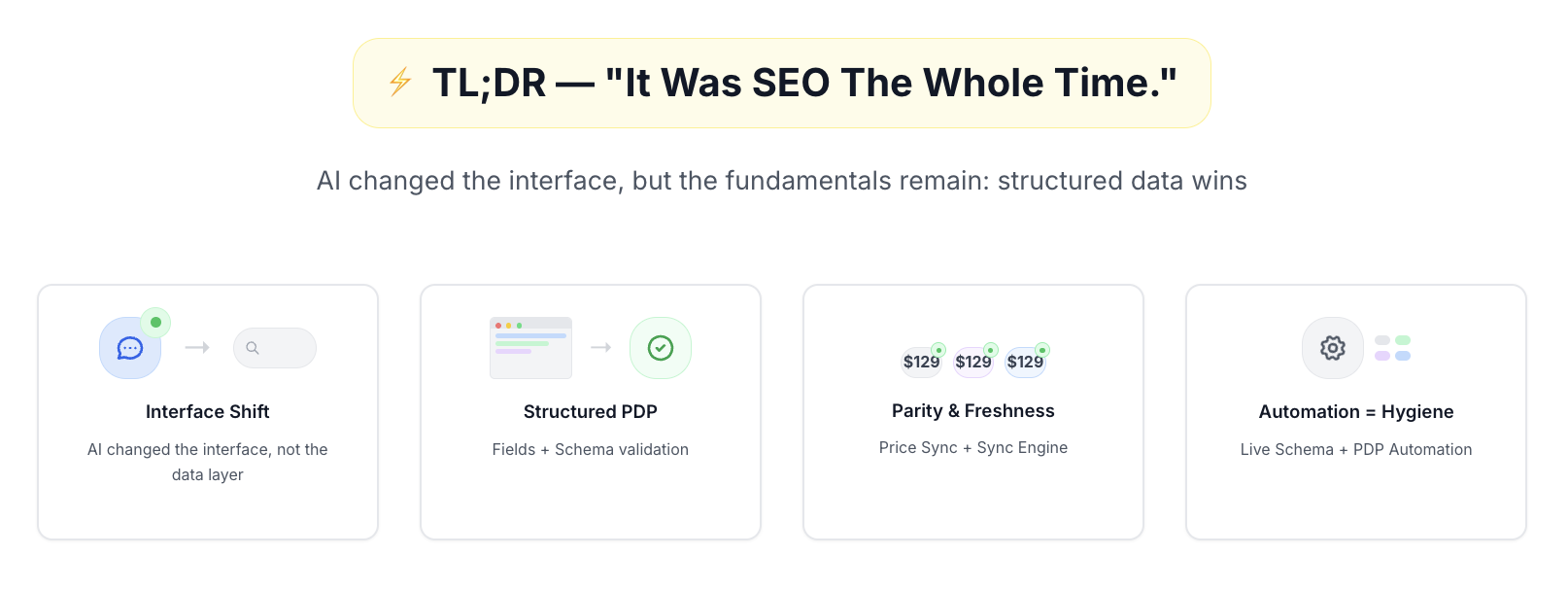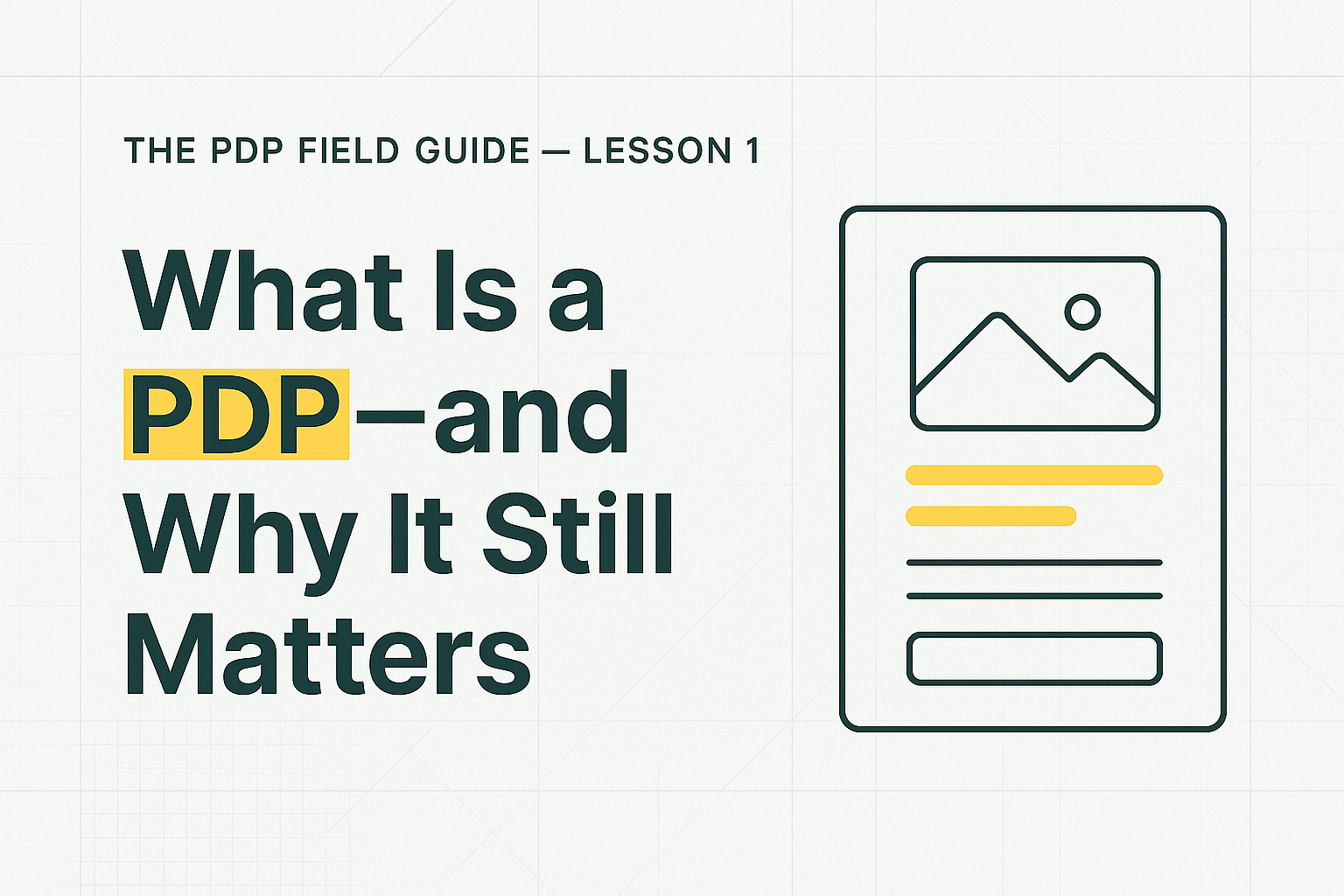.png)

It Was SEO The Whole Time: How To Be Cited By AI

⚡ TL;DR — It Was SEO The Whole Time
- AI changed the interface, not the data layer. Win the data layer with Structured PDP Fields and Product Schema.
- LLMs cite authoritative, corroborated, structured sources. Pass Schema Validation and enforce Field Consistency.
- Kill invisibility by fixing parity & freshness: Price Sync + Sync Engine to eliminate Feed Drift.
- Automation ≠ more copy. It’s field hygiene at scale: Live Schema Generation + PDP Automation Workflow so you’re LLM-Ready.
1) The Confusion Loop
“Optimize for AI” sounds new. In practice, most teams just renamed fundamentals:
- Crawlable, machine-readable Structured PDP Fields
- Valid, complete JSON-LD for a Product Rich Result
- Consistent facts (price, availability, variants) across PDP ↔ feeds ↔ marketplaces (Price Sync)
- Strong entity/brand signals reinforced by internal linking and corroboration (Field Consistency)
If those aren’t in place, you’re invisible—both to Google and to AI surfaces. Start here: What Is a PDP—and Why It Still Matters and The Shift: From Content to Structure.

2) Data Layer vs. Interface Layer
- Data layer: Everything machines read: PDP HTML, Product Schema, sitemap.xml, feeds, and off-site corroboration.
- Interface layer: How results are displayed: Google links, AI answer boxes, marketplace tiles, social shopping cards.
You can’t optimize the interface. You can only become an unmissable source in the data layer via Structured Product Data, Schema Validation, and ruthless Field Consistency.
Deep dives: How Google Evaluates Product Pages and How Meta, TikTok, and AI Feeds Read PDPs.
3) How AI Engines Choose Sources (What Actually Moves the Needle)
- Authority & corroboration
- Clear entity signals (brand, model, category) that match across your site and retailers. Use breadcrumbs and intent-based linking (collection → PDP → accessories).
- Breadcrumb Schema and Visibility Gaps.
- Structure & completeness
- Valid JSON-LD with required + recommended properties: name, brand, SKU, GTIN/MPN (if available), images, description, offers (price, currency, availability), reviews (if present).
- Pass live checks with Schema Validation and a Feed Diagnostics Report.
- Parity & freshness
- Eliminate Feed Drift between PDP and feeds. Automate updates with a Sync Engine and documented Update Cadence.
If you’re strong on these three, you’re already LLM-Ready.
4) Common Take vs. Correct Take
Common take: “We need GEO/AEO/LLM-SEO tools.”
Correct take: Get unskippable at the Source of Truth.
- Build pipelines: Data Pipeline + System Integrations.
- Prioritize Attribute Completeness, Alt Text, and Open Graph Tags aligned to product facts (not copy for copy’s sake). See Avoiding Copy/Paste SEO.
- Clarify PIM vs CMS roles and move changes via Bulk Update API (not brittle Manual Workflows).
5) What PDP Automation Really Means (EKOM POV)
“Automation” isn’t AI writing more copy. It’s the discipline that keeps fields correct everywhere:
- Auto-inject Live Schema Generation for Product Schema
- Enforce PDP ↔ feed ↔ marketplace parity (price, stock, variants, images) via Price Sync
- Maintain Change History Log and rollbacks
- Monitor for PDP Drift and Content Expiration
- Prove impact with Feed Approval Rate and error reduction
Start here: What PDP Automation Really Means, Where Automation Fills the Gaps, and Inside EKOM’s System (Case Study).
6) The Watchman Checklist: Make AI Cite You
Use this on every Product Detail Page:
- Schema completeness: Valid Product Schema (required + recommended). Fix Schema Errors.
- Parity: PDP price/availability/variants exactly match feeds & marketplaces (Price Sync).
- Entities: Brand, model, category names consistent; Breadcrumb Schema implemented.
- Images/ALT: Primary image ↔ primary variant; Alt Text states attributes (color, material, size).
- Linking: Collection → PDP → related accessories; no dead ends; Faceted Navigation considered.
- Freshness automation: Inventory/price flow PIM → PDP → feeds with alerts for Stale Inventory Flag. See Product Information Management and Sync Engine.
- Cross-platform validation: Run Cross Platform Checks for Google, Meta Commerce, and TikTok Schema.
- Governance: Field owners, SLAs, and a documented plan with quarterly tune-ups—PDP Field Governance Plan and Quarterly PDP Refresh Cadence.
When these are green, AI surfaces reliably “see” you.
7) 14-Day Implementation Playbook
Days 1–3 — Audit
Use Health Audit and log Field Updates (schema presence/validity, missing attributes, feed vs PDP deltas).
Days 4–7 — Fix the data model
Standardize attributes by category (Taxonomy Standards). Set rules for Canonical URL and authoritative naming.
Days 8–11 — Automate sync
Connect PIM → PDP → feeds with a Sync Engine; enable Live Schema Generation and parity checks.
Days 12–14 — Validate & monitor
Lift Feed Approval Rate; remove Scaling Failures; ship dashboards for Data Completeness and alerting (optional Content Tag Manager).
8) Proof, Not Platitudes
Vendor documentation to cite in the live post:
- Google: Product structured data
- Google: Rich Results Test
- Google Merchant Center: Mismatched price/availability policy
- Schema.org: Product
- Meta: Commerce Platform docs
- TikTok: Shop product data
The Takeaway
If AI “killed” SEO, why do LLMs keep citing pages with clean schema, consistent facts, and strong entity signals? Because the interface changed—the rules didn’t. Fix the data layer and you’ll be visible everywhere the answers appear.

